Dear Artist,
Today the main thoroughfare of Baie-Saint-Paul is closed to vehicular traffic. Thousands of visitors dine on outdoor sushi, sugar pie and onion soup served up in plastic cups. At least a hundred painters operate from homemade paintboxes, massive “tabourets,” French easels and Stanley Mobile Work Centers. Anything goes — oil, watercolour, acrylic. Amateurs rub shoulders with seasoned pros. As it is in life, some know what they’re doing, others have lots to learn. Visitors watch the painters and wander in and out of the nearby commercial galleries.
Unlike many similar venues, each artist has no kiosk where goods might be sold. Painters arrive in the morning with blank canvases and fill them up during the day. I saw a few wet ones being triumphantly carried off to the nearby parking lots. It’s all fun, it’s all democratic, and it’s full of characters — a bit like street-juggling with curious crowds gathering and moving on. One grinning fellow wears outrageously paint-spattered, comic coveralls while holding a gigantic palette. He squeezes paint directly onto his canvas and moves it around with two brushes at once — one in each hand. His well-pierced lady paints nearby and keeps an eye on their mutual infant.
Farther down, I talked to Marie Benois. She’s been painting “professionally” for four years. She lives with eight-year-old Simon in a nearby walk-up. Her semi-primitive acrylics sell for one to five hundred dollars and provide enough to get by. “The winters are bad,” she says. “There’s no one here.” She has newspaper clippings and an album of “solds”–each photo with a big red dot. Her current painting is like the ones in the album. “I sold to Angelina Jolie,” she says. “At least she looked like her.” The album shows a photo of her and “Angelina Jolie.” I ask if she ever wanted to get into a gallery. “No,” she says, “Why should I give my money? I don’t do the Internet either. People want to meet with me, to see me. They like me. Then they like my art.” Marie has a shy smile and mascara eyes. Simon, tousle-haired and equally attractive, comes by for a twenty.
Many of these street artists have not had the benefit of art schools, workshops or even books. They just go for it. Others have well-honed facilities and don’t care if they sell. A seasoned gentleman looks beyond his knife-painting at the bubbly Marie. “Doesn’t matter what people do,” he tells me, “You should try painting. It’s good.”
Best regards,
Robert
PS: “I went into the business for the money, and the art grew out of it. If people are disillusioned by that remark, I can’t help it. It’s the truth.” (Charlie Chaplin)
Esoterica: “For the things we have to learn before we can do them,” said Aristotle, “we learn by doing them.” What about preciousness and advanced creative thinking? The local public gallery, the “Centre de Exposition” is virtually and seriously vacant. All the joy is being had over here on Rue St. Jean Baptiste. Maybe the elderly knife-painter has the right idea. Art is a doing thing and it doesn’t matter what it looks like. People will take it home anyway. And that’s a start. And Simon is learning all about sushi.
Street art at Baie-Saint-Paul, Charlevoix, Quebec
More street events needed
by Karen Gillmore, Victoria, BC, Canada
I am curious to know whether the street art event in this clickback happens on a regular basis, or if it is a once-yearly festival. We have a similar annual event in Victoria called The Moss Street Paint-In. I think every city should have regular events like this, to get the idea of art out there to people who wouldn’t usually encounter original art, especially original art being made. In these days of mass-produced everything, where we are distanced from the producers of everything we “consume,” those of us who make things with our hands must use every means we have to connect and share our art with people. Painting in public, giving demonstrations and hands-on workshops, and teaching are all ways to give people an appreciation of where the art that surrounds them comes from, be it a fancy wine label, a billboard, or a painting on the wall. Where do you get the Stanley Mobile Work Center? It looks like it would not only be good for outdoor painting, but for those of us who have to lug portions of our studios along to classes!
(RG note) Thanks, Karen. The Baie-Saint-Paul event is held every weekend during the summer. The last one for the year was last weekend. Regarding the Stanley Mobile Work Center, they are available in hardware stores and chains — anywhere Stanley tools are sold, or on Amazon where it is described and listed at $42.00.
Standing out from the crowd
by Tai Ward-Holmes, Queenstown, New Zealand
I am a fulltime artist who sells in a Saturday market situation, because selling art is a numbers game; the more people who see your work, the higher the opportunity to sell a painting. Galleries appear to look like morgues these days whereas a market gives direct ‘live’ feedback, immediately. It allows production in the studio during the week and networking and selling on market day. Plus, there are no high commissions to pay. And, if you do sell via an art gallery and have an opening art exhibition, the attendees are not other artists, who are non-buyers, or those who are there habitually to sip away on the wine. I have also found that not having a web site in a market situation can be a plus. With a web site; it goes like this. Customer: “Do you have a web site?” Yes, here’s my card. “Great, I’ll check it out later! Thank you, goodbye!” Without a web site: You: “Sorry, I don’t have a web site; do you have an email address?” Yes! “I can email you a photo image of the painting. How about I take a photo of it, with you in the picture?” Yes, that would be great, thank you … blah blah blah … that is so cool. You get to add their email address to your database for a future newsletter and, possible sale. It also keeps ‘your name alive’ with the customer and, they will remember you because they received an image of your work. So, I say YES to markets and YES, to even being an ‘artist in residence’ at any open art exhibition you may enter. Why? Because you and your art need to stand out from the crowd. You don’t need many sales in a market situation to make a good living from your creativity and, it will elevate and promote your confidence in a positive way which charges your art to higher levels.
Artist’s complex located in old village
by M.K. Puri, New Delhi, India
In New Delhi we have an artist complex in the heart of the city where around 100 artist working in different disciplines like painting, sculpture, print making or ceramics, come and work. This complex has studios around green lawns and provides an ambience suited for a creative endeavour. In the evening the local village (a city village now) folk, mostly women with children, come and sit in the lawns. But these people are not in any way interested in the art activities happening in this complex. Nor is this place is as you have described in your letter humming with artists and art lovers. Yes art lovers/ buyers do come here occasionally. This complex celebrates an art festival every year with pomp and show, with young and senior artists from other cities also invited to participate. There are seminars, film shows along with an evening with music. This complex was established for the artist community by some of our very senior artists with government funding. So it is basically a government organization. But it does have its independent character purely with the artist being the basic runners through the government establishment. It is called Garhi artist complex. (Garhi is the name of old village which is as good as a city area except that the original village people still live there.)
Site painting based on too few galleries
by Rod Mackay, Lunenburg, NS, Canada
The paint-on-site phenomenon in Nova Scotia has been impelled by the fact that there are too few galleries for too many people. At first Lunenburg was the only community to sponsor a two-day event for artists from across the province. Now every small town has a plein air show and sale, the wet paint items being auctioned daily. In Lunenburg part of the proceeds go to underwrite the Lunenburg Art Gallery which is committed to the cause of rising and/or amateur artists. In Mahone Bay a percentage goes to the Settler’s Museum; at Port Royal… well you get the picture? The cumulative result of all this activity? Each event raises a bit less money currently than it did the year before, and more than one, is on a slippery slope. Most professionals avoid these plein air events, choosing to exhibit a few studio paintings in the annual sales, where the price is controlled by the artist. Artists tend to be liberal thinkers, but it is well to respect the Sunday-Go-To-Meeting Crowd’s right to be free of the perceived sin of working on a Sunday. Personally, I paint well away from public habitations and churches on Sunday, often working in completely public territory, such as the intertidal zone.
Keeping artists humble
by Clarinel Stamos, Villa Park, CA, USA
The remark that the painter made to you, “Even you should try it,” reminded me of the video that Wayne Thiebaud had made to mark the entrance to a display of his wall art. In it he shared some of his process and sites for subject matter. In closing, he told a story of how he was set up on one of those amazing San Francisco streets. People would pass by. Some would linger. One fellow paused a little longer than usual. He asked Thiebaud (paraphrased) “How long does it take you to paint one of those things?” Wayne T. answered, “A few weeks.” The spectator said, “I saw an artist on TV who can show you how to do that in 30 minutes.” There’s always someone out there to keep us humble.
Public amusers
by Ion Danu, Sherbrooke, QC, Canada
Every summer, with a friend who has a car and is, just like me, “malade de cette art perimé de la peinture” (Bonnard’s words from a letter — 1934), we go to the city’s parks and we draw/paint portraits… My friend Clement Bolduc draws portraits in pastels and sanguine, myself I use acrylic inks and watercolor. In a good day, we do 5-6-7 portraits (about 30 minutes time for one portrait). If the model likes his/her portrait they pay me a minimum of 3-5 dollars (the price of materials I use) in order to keep it but the main thing is the connection, the feedback, the chat with people during their “pose”… Usually, we talk about painting and I tell them anecdotes with artists, usually very poor (and then, post-mortem, famous, like Van Gogh…) It’s really great and sometimes I make nice portraits and even have the ‘impression’ that I get across and understood something new or important about people… and painting, drawing, art is the vehicle, the intermediary… I’m not discouraged or ashamed by the title they give me at the city hall: public amusers (amuseurs publiques). On the contrary, I’m proud and honored. Even if I am now a professional artist — with works in Galleries and presence on the Internet and so on — the persona I prefer is probably the “street artist” persona.
On the street in LA
by Paul deMarrais, TN, USA
Years ago I sat out in the blazing sun on La Cienega Blvd in Los Angeles with my pastels. I thought it was so depressing lugging those aluminum frames around at the beginning and at the end. The vendor doing the most business was selling prints of little pornographic ink drawings for three dollars. You could see the people attempting to hide their purchases in various ways. There was an attractive woman next to my space selling formulaic landscapes that were pretty bad. On the wall next to her paintings was a resume board with an article saying, “Miss Universe Now Appearing” in some city etc. You were supposed to infer that perhaps she was an ex beauty queen. The woman’s husband/partner was a fast talking peasant type who would openly harass would-be buyers if they lingered at her station. As if on queue the woman would appear with a baby in a stroller if there was a possible buyer. Family values. One guy was ready to buy a handful of her paintings but his female companion kept telling him he could do better somewhere else. Finally he left and the peasant went into a fit of rage cursing a blue streak about the meddling woman and how she cost him a thousand dollars. It was a comedy but to have a part in it was too grim for me. I often wonder why amateurs want to join our circus. There are so many easier ways to make a dollar!
Simple, spontaneous mantra
by Kim Attwooll, Tryon, NC, USA
Bruno Cote’s “EMTD” made me smile, it’s so true. My mantra is “SS” “Simple, spontaneous.” Unlike you heroic artists seeped in grandeur and size, I paint small. While your work delights and inspires me, I stick to tiny works allowing me freedom from accepted practices and rules. I am a member of a very happy minority, those who spend their time doing what they love, and make their living doing so. I attended Wallasey College of Art in England, and after a few detours, got the opportunity in 1996 to paint full time. I supply galleries and lovely shops across the U.S. with my original watercolors. They are sold mounted on blank 5×7 cards and as such are highly affordable original art. With over 500 images in 20 categories I paint thousands per year.
The fun begins as I enter into the spirit of my subject, striving to keep the painting simple and spontaneous. Sometimes the use of negative space is the most effective. Wet on wet is always an adventure. Many “tricks” even table salt add texture and effect. The colors always remain a reliable joy! Watercolor allows me such variety, and by painting small areas I avoid most of its constraints. Even when the inevitable glitches of the medium occur, I am often pleasantly surprised. My goal is to remain in this highly creative state, and relate with enthusiasm that watercolor is such much fun.
Toxic paint
by Mark D. Gottsegen, Greensboro, NC, USA
Simply using linseed oil as a substitute for a thinner in an oil painting is perhaps not such a good idea: Linseed oil yellows and grows brittle as it ages, and you would likely be accelerating those effects, depending on environmental conditions. Instead, it might be wiser to use a little odorless mineral spirits as a thinner in the beginning stages of a painting, then paint straight from the tube, and then finally add a little of an oil/alkyd medium near the end. There are many brands of both the odorless mineral spirits and the oil/alkyd mediums to choose from. People may be a little confused by the term “turps,” which has been a traditional nick-name for gum turpentine. You certainly want to avoid the use of gum turpentine, which is far more harmful/toxic than odorless mineral spirits. (Perhaps you are thinking of a turpentine substitute of some sort.) On the other hand, all the labels of the various odorless mineral spirits carry warnings about over-exposure to the vapors and the requirement that the user provide replacement air ventilation. Yes, there are pigments sold that can have toxic affects if they somehow make it into your body — through the skin or the mouth, or breathed in. Pigments ground into paste paints also might pose a risk, but also yes, it’s fairly easy to adopt safe painting practices that will protect you from harm.
(RG note) Thanks, Mark. Mark Gottsegen is building an educational resource on art materials at www.amien.org His information has no bias towards any product or manufacturer.
Wisdom of oils
by Colin Williams, Vancouver, BC, Canada
I worked as a housepainter for 3 years and the fumes of the “safe” water-based latex/acrylic emulsion paints really started to get to me. Large doses of acrylic art paints and primers have the same effect. Any good paint is just pigment in a vehicle. Oil paint is as safe as the pigment it is made out of. You can eat linseed and safflower oils on your salads. So I don’t care what M. Cote thinks, but I betcha acrylics are actually more toxic than oils because they release all kinds of synthetic chemicals when they dry. Oils are only more toxic during the clean-up process if cheap solvents are used. (Gamsol is great when necessary, and it takes me about 3 months to go through a litre, and it doesn’t make me loopy when I do have to use it). Oils have only fallen out of fashion because, in our plug-and-play society, acrylics are more convenient for hobbyists, and take the elitism out of the medium. I also paint in oils because they to not allow me to over-paint my screw-ups instantly. I have a week to look at it, learn from it, and not botch it further by correcting it too impulsively. This adds to the contemplative process art should be. That, and I could never get the look I want with acrylics — it suits me to paint with oils, even en plein air. It is totally by choice, and not because I am a retro-grouch (well, because of that too).
Learning to paint from TV
by Janet Bowser, The Big Woods, PA, USA
What do you think of people, such as myself, who are learning to paint via Bob Ross and Frank Clarke? I feel like when I do a painting, whether from one of the “lessons” or one which is “out of my own head” I am really doing something that brings me up emotionally, but many people in the art community treat this type of painting with tremendous disdain.
(RG note) Thanks, Janet. As a believer, I take the position that it’s okay for folks to start anywhere they want. But beginning painters should realize that there are highly evolved mentors who are not quite as high profile but also available. Art is a test of discrimination as much as acquiring skills and tricks. There’s no need for disdain, but artists need to think things out. The best emotions are the more lofty ones. Your own personal stamp is worth something too.
Archived Comments
Enjoy the past comments below for Street Art…
I can empathize with the artists of Quebec as an artist that has both exhibited and painted on the street in other countries. So many of the strollers are more interested in food but I have no doubt that a few dollars changed hands and that some artist and clients went home happy.
Robert thank you for your wonderful and interesting newsletters. I have wanted to ‘be’ an artist-writer since I was 6. My life took me down another route but finally at 54yo I began actually painting. I have not had lessons, I learn through books and people like you who are willing to share information. It astounds me that some people actually don’t want to give out little secrets they have. I am becoming good enough to call myself an artist now but due to heavy family obligations I can’t do the things others do, like participate in the Baie-Saint-Paul street art fair. Your newsletters give me a taste of art and the world that I could not experience otherwise. I look forward to them and save them to share with other artists when given the opportunity. Keep up the good work. Jay Wright
The debate over acrylics as opposed to oils continues to grow. I have been an acrylic painter for over 25 years and though, there is a myth that you can over paint instantly, it is not true. Even acrylics have a drying time. I am still, after all these years learning the value of the medium and what I thought it would do. There is no end to how far you can go, how much you can change and what effect you can derive from this medium. I teach a pastel class in one of our senior centers and have found that most of those who have painted in one or the other, do not paint, as hobbyist, in acrylics. It is not nearly as simple a medium as it has been classified. I once had a gallery owner tell me that acrylic painting did not command as much money as oils, because they were easier. Obviously, this woman had not attempted to paint with acrylics. As far as toxicity, all forms of art materials, when dealing with pigments are toxic. Using them responsibly is up to the artist.
I agree that acrylics may not be so safe. When I was taking graduate courses at SUNY-Albany (State University of New York – Albany) there was talk then that those who worked with acrylics for long hours indoors seemed to have a higher rate of brain tumours than other artists, printmakers being the only exception. I also have a friend with many allergies; she cannot use acrylic paint, and had to cover with builders foil, all her acrylic-painted walls in her new studio. She now usess them outdoors, and works with gouache indoors. Oils bother her, and she thinks it might be the driers, as the oil itself is from edible sources.
Art fairs are a lot of fun and I did them for many years but now I consider myself mostly retired from them. I just do one a year now. As for art supplies, well choose your poison. I figure the most poisonous thing around is a negative attitude. Positive thinking and a little common sense when dealing with art supplies go a long way.
Thanks for the info about acrylic fumes when they are drying, now I know why I can leave the studio feeling a little stupified! I always thought that acrylics were a safer alternative, as my daughter suffers from asthma. I will now ask my long-suffering husband to help me install an extractor fan in my studio!
Be sure to check prices on mobile tool carriers. I have been using a Mastercraft from Canadian Tire for years. I also found several configurations of these things, so it pays to check out a few. Take care.
These black lines on Cezanne’s work seem the scribblings of someone who knows little of painting. To say arbitrary is the least of it.
Robert, you said what is one of the pithiest and most important things of all in your response to Janet Bowser, in her query to you about “Learning to paint from TV”. You said, “Art is a test of discrimination as much as acquiring skills and tricks. There’s no need for disdain, but artists need to think things out”. I’ve tried very hard to get this idea across to students. Not everything they ’emote’ onto a canvas is good. Before considering it finished enough to show others, they need to examine it in a discriminating fashion and make any changes necessary to ensure that it proudly represents what they consider to be a good work of art.
I was soooo tempted to get my cookie cutter shapes and start stamping Cezanne’s paintings then publish my book. I couldn’t figure out what the logic was behind the shapes, cones and such. I think cookie cutters are more fun. So, my dear Cezanne, cut up a cookie and enjoy it.
As an artist fairly new to the experience of working with oils I was very inspired by the endless possibilities it awarded me. I worked long into the wee hours of the night for weeks, maybe months. I considered my space well ventilated with overhead fans and an open door. I also added Japan drying oil, colbalt blue medium,liquin original, pale drying oil, etc. Ignorant to the toxic affects that these fumes had on me and my environment, I got real up close and personal with some of my work. At times,I would fall asleep in the same room just to see my new creation in the first morning light with a fresh outlook. Only I began to discover things weren’t that fresh eventually! Yes I did read the warning labels and thought it can’t be that bad. I noticed my vision begin to blur and I would get what I called the spins. One morning I looked in the mirror and my face was drooping on my left side ever so slightly. Eventually it worsened and a co-worker exclaimed, you have bells palsey! I thought I was permenantly disfigured and wondered, what other side effects had taken place and how long do they last? After cleaning out my room and moving my work elswhere the symtoms disappeared in a week or so. I’m still a little dizzy here and there but come to think of it, I always have been…at least I’m not considering cutting off my ear or painting drooping clocks. I wonder if “they” ever slept with their paintings?
Funny you should mention Cezanne’s compositions. I have a book 3rd ed. by Erle Loran 1963 called Cezanne’s Composition (analysis of his form with diagrams and photographs of his motifs). It dissects many of his paintings completely into geometrical relations. I wonder very much whether Cezanne himself put that much analysis into his compositions. It was originally printed 1943 by U of California Press.

Basics; Air Encaustic painting, 24 x 24 inches |
You may be interested to know that artists from every state in the USA, every province in Canada, and at least 115 countries worldwide have visited these pages since January 1, 2013.





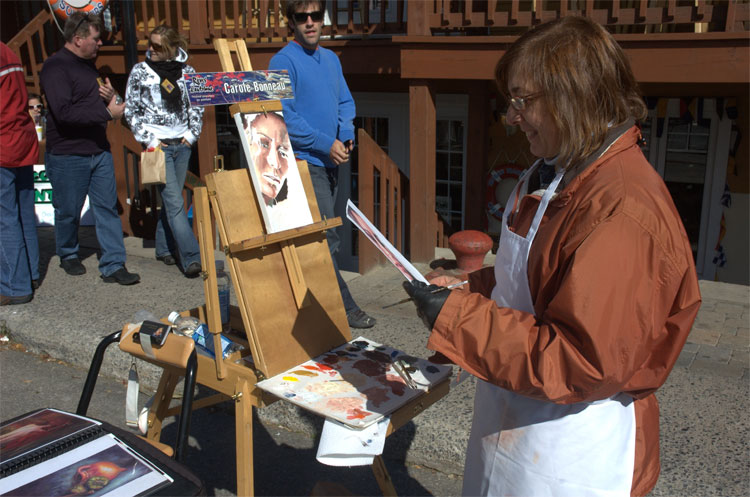
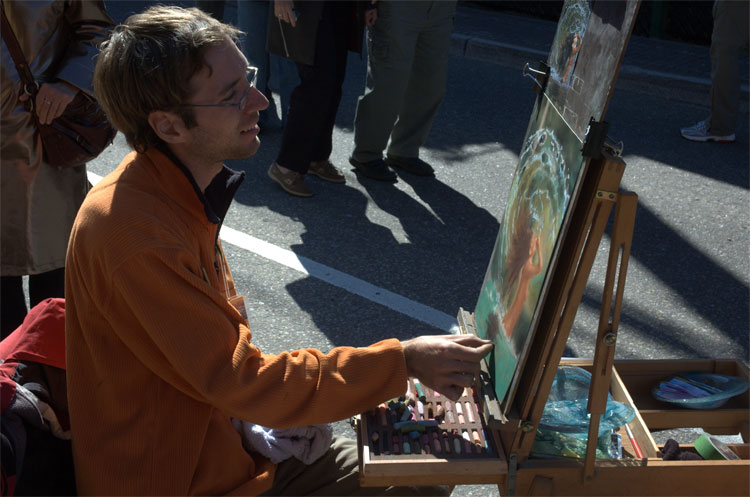
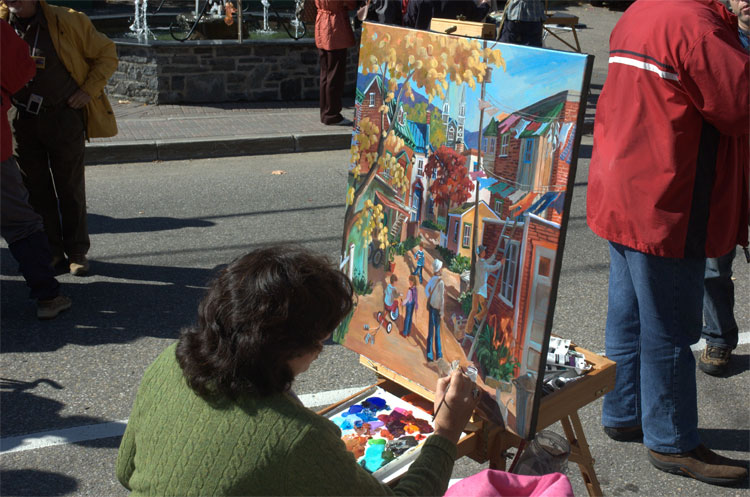
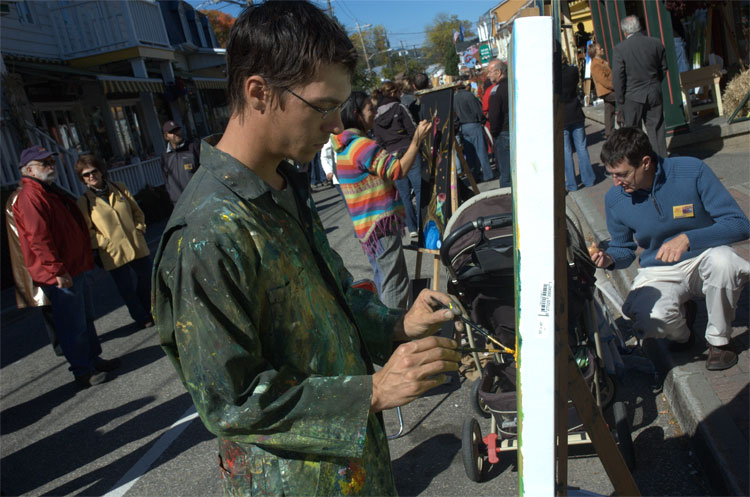






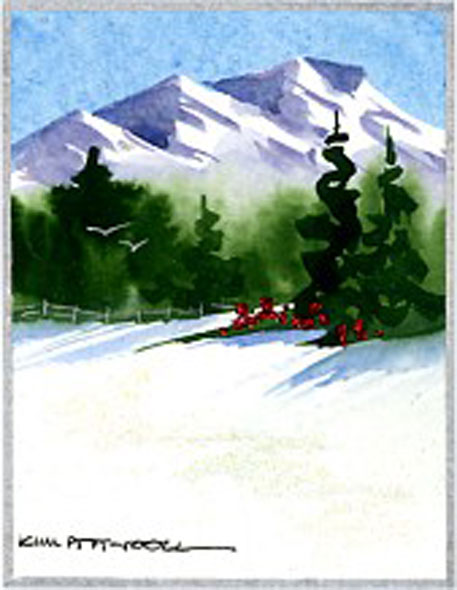

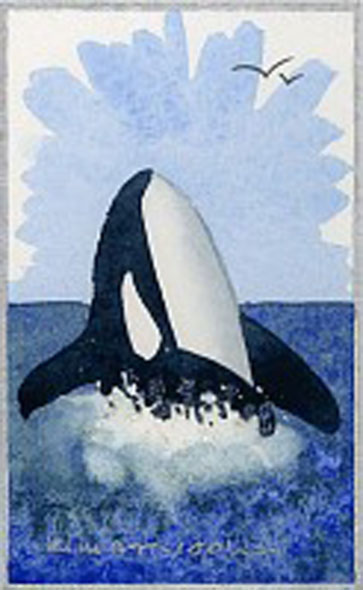





Street art is great fun. I’ve been to street fairs and participated in them. Have done caricatures at them as well. I can feel the energy sizzling right out of the photos. Think of the great dawn chorus — we’re all birds singing, some of us are songbirds, others herons, but for the day, it doesn’t matter. It’s the process and experience that delight. I, too, paint with both hands as I’m completely ambidextrous, a handy trait to have standing at an easel. I also draw and write with either hand. I love your letters, look forward to Tuesdays and Thursdays as special days in the week. Want to thank you publicly as so many others have done. You enrich my life.